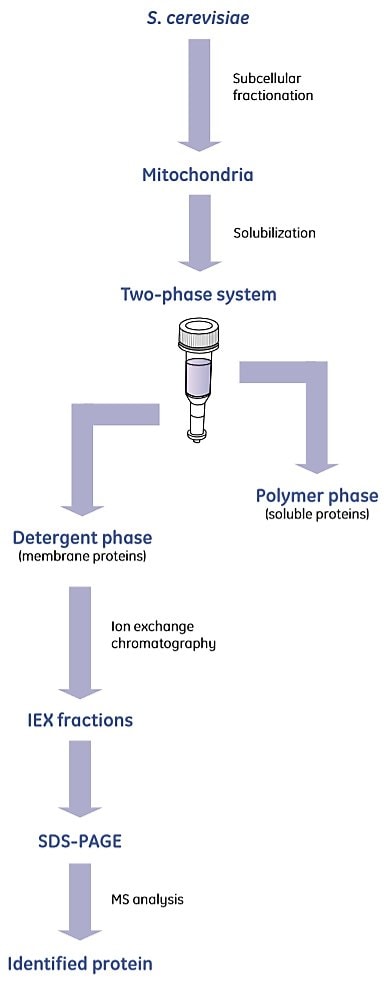Proteomic Analysis of Membrane Proteins
A common objective of the proteomic analysis is to identify and quantitate all proteins expressed in a cell or a tissue at a particular point in time. The standard approach towards this goal is to separate proteins by 2-D gel electrophoresis followed by trypsin digestion and analysis by mass spectrometry (MS). However, cell surface proteins, and in particular integral membrane proteins, can be difficult to detect in a 2-D gel without prefractionation by chromatography or some other type of enrichment. This is due to their low abundance and the difficulty of solubilizing membrane proteins and of maintaining their solubility in the first-dimension separation (isoelectric focusing)
Prefractionation Using an Aqueous Two-phase System
In one example of prefractionation, mitochondrial proteins from Saccharomyces cerevisiae were fractionated in an aqueous two-phase system (Figure 1) consisting of a polymer and a non-ionic detergent. Membrane proteins were enriched in the detergent phase, which was then used for ion exchange chromatography. Eluted fractions were further separated by SDS-PAGE and gel bands were analyzed by MS. More membrane proteins were identified by this method than by using 2-D gel electrophoresis alone.

Figure 1.15Mitochondria from S. cerevisae were isolated by differential centrifugation. The isolated mitochondria were fractionated in a detergent–polymer aqueous two-phase system formed by addition of polymer and salt to the detergent solubilized mitochondrial membranes. Membrane proteins partition to the detergent (bottom) phase and the bulk of soluble proteins to the polymer (top) phase. The detergent phase was further fractionated with ion exchange chromatography and fractions were analyzed with one-dimension gel electrophoresis. Bands were identified with MS analysis. Used with permission. Copyright 2004. Elsevier BV.
Selective Labeling of the Extracellular Portion of Membrane Proteins
CyDye™ DIGE Fluor minimal dyes can be used to visually enrich for, and detect the extra- cellular portion of membrane proteins. The method is fast, simple to use, and prefractionation is not required. All CyDye DIGE Fluor minimal dyes can be used to label cell surface proteins. These features allow for multiplexing using EttanTM DIGE technology and analysis of protein expression using DeCyderTM 2-D software. In this way, small changes in abundance can be detected with high accuracy, and results are supported by defined statistical methods. This protocol is schematically shown in Figure 2.

Figure 1.16Outline of a procedure for selective labeling of cell-surface proteins using CyDye DIGE Fluor minimal dyes.
Buffers
Hanks Buffered Salt Solution (HBSS):
137 mM NaCl, 5.4 mM KCl, 0.25 mM Na2HPO4, 0.44 mM KH2PO4, 1.3 mM CaCl2, 1.0 mM MgSO4, 4.2 mM NaHCO3, pH 8.5
Labeling buffer: HBSS, 1 M urea, pH 8.5
Lysis buffer: 7 M urea, 2 M thiourea, 4% CHAPS, 30 mM Tris, 5 mM magnesium acetate, pH 8.5
2× Sample buffer for CyDye DIGE Fluor minimal dyes:
7 M urea, 2 M thiourea, 2% CHAPS, 2% IPG buffer pH 3–10, 130 mM dithiothreitol
Material
CyDye DIGE Fluor CyTM2 minimal dye
CyDye DIGE Fluor Cy3 minimal dye
CyDye DIGE Fluor Cy5 minimal dye
Procedure
- Grow the cells of interest until a minimal cell number of 5-10 × 106 cells (confluent or cells in suspension) is reached. For cells growing in suspension, proceed to step 3.
- Carefully detach adherent cells non-enzymatically (cell dissociation media, enzyme free PBSbased).
- Count the cells and pellet them by centrifugation. For the following steps, keep the cells on ice.
- Wash the cells by resuspending the pellet in 1 ml cold HBSS buffer, pH 8.5, and transfer to a 1.5 ml microcentrifuge tube. Centrifuge the suspension at 800 × g and 4°C for 2 min.
- Remove the supernatant and resuspend the cell pellet (containing 5-10 × 106 cells) in 200 µl cold labeling buffer. Add 1.5 µl CyDye working solution (600 pmoles). Mix briefly by vortexing at slow speed.
- Label the cell surface for 20 min on ice in the dark. To quench the reaction, add 20 µl of 10 mM lysine and incubate another 10 min.
- After labeling and quenching, wash the cells twice in 500 µl cold HBSS pH 7.4 by centrifugation at 800 × g and 4°C for 2 min.
- Resuspend the pellets directly in 150 µl cold lysis buffer and leave on ice for at least 1 h with occasional vortexing. Centrifuge the lysate at 10 000 × g and 4°C for 5 min. Transfer the supernatant to a new tube.
Note: Fractionation of the sample may be desired. It is not necessary for improved detection of cell surface proteins but could be used to verify lack of labeling of cytosolic proteins. After fractionation the sample can be directly applied on 2-D electrophoresis.
- Add 2× sample buffer to the lysed cell surface labeled sample. Now the sample is ready for 2-D electrophoresis. Proceed with the recommended protocols for 2-D DIGE electrophoresis.
Table 1 provides a summary of measures that can be taken to overcome the challenges associated with 2-D gel electrophoresis of membrane proteins.
An alternative to the 2-D gel electrophoresis approach is “shotgun proteomics” involving solution proteolysis of proteins followed by peptide separation by liquid chromatography and sequencing by MS/MS. To specifically study membrane proteins with this approach, the membrane fraction is typically obtained by cell disruption (for methods, Table 1.2 in Performing a cell disruption and membrane preparation) and differential centrifugation to prepare organelles and cell membranes. The detailed centrifugation protocol will depend on the cell type studied. Some alternative methodologies for the subsequently combined solubilization and proteolysis step are listed in Table 2.
*This procedure involves cleavage (and identification) of the exposed hydrophilic domains of membrane proteins, but not global solubilization.
Um weiterzulesen, melden Sie sich bitte an oder erstellen ein Konto.
Sie haben kein Konto?